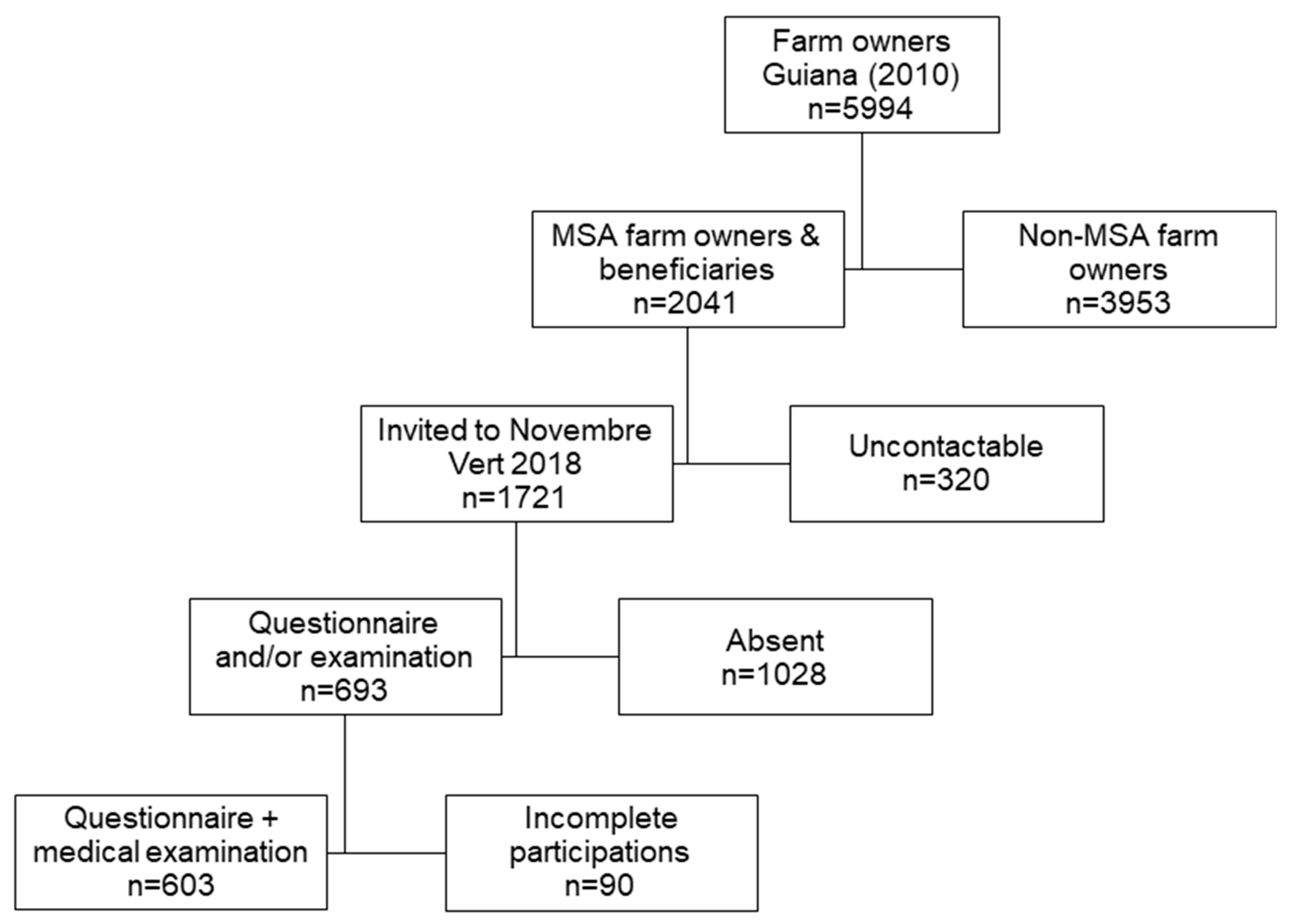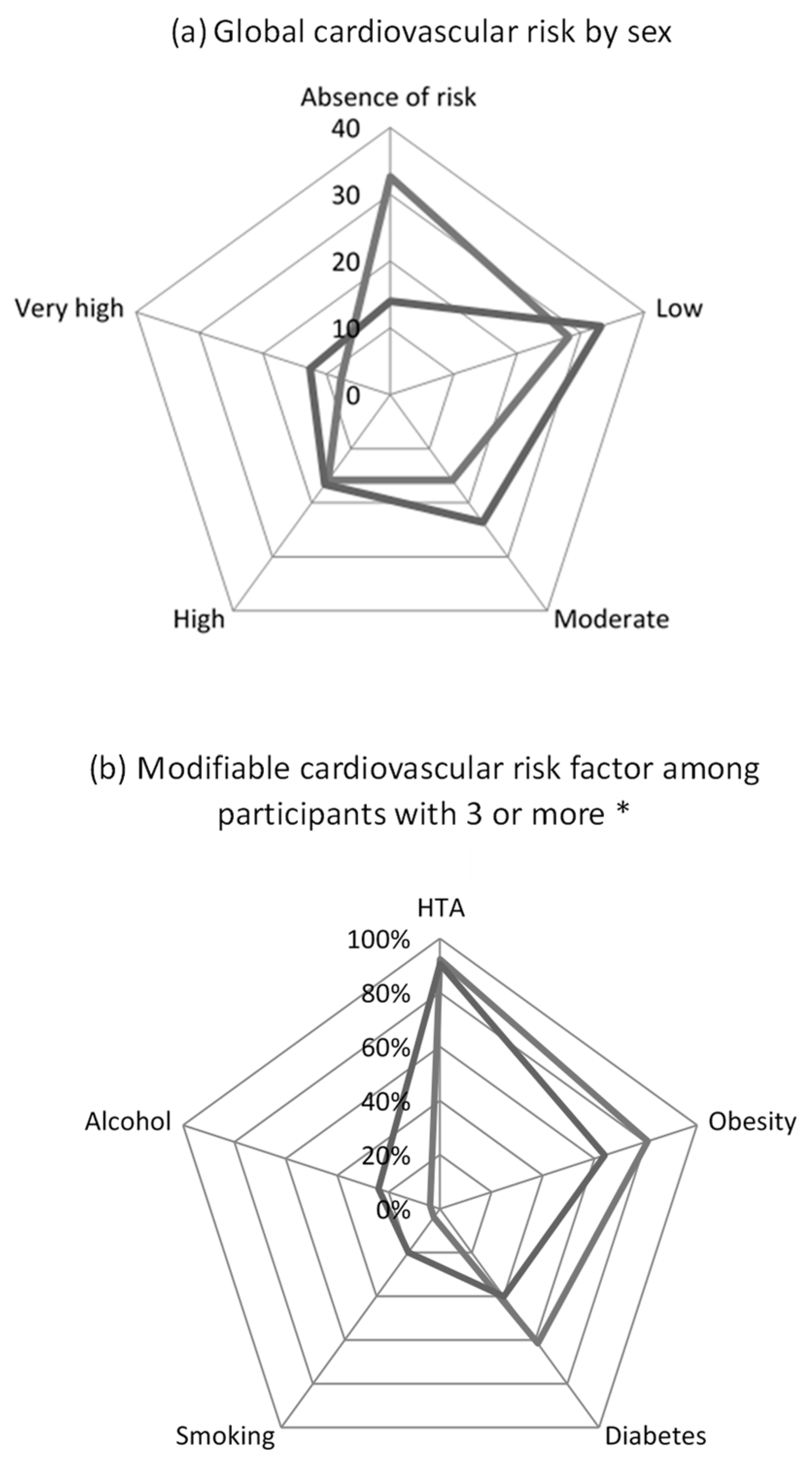Cardiovascular Risk Assessment among Farmers in French Guiana in 2018—A Screening Program
Abstract
1. Introduction
2. Materials and Methods
2.1. Study Design and Population
2.2. Variables
2.3. Satistical Analysis
2.4. Ethical and Legal Aspects
3. Results
3.1. Participants
3.2. Cardiovascular Risk
3.3. Professional Qualification
4. Discussion
5. Conclusions
Author Contributions
Funding
Institutional Review Board Statement
Informed Consent Statement
Acknowledgments
Conflicts of Interest
References
- Baldi, I.; Cordier, S.; Coumoul, X. Pesticides: Effects on Health; National Institute of Health and Medical Research (INSERM): Paris, France, 2013; Volume 162. [Google Scholar]
- Equête Agrican, Bulletin Number 3: Agrculture and Cancers. 2020. Available online: https://www.agrican.fr/etude/bulletins-informations (accessed on 1 January 2020).
- Rose, M.J. A Still Sustained Demographic Growth, Demographic Review of Guiana 2018; French National Institute for Statistical and Economic Studies: Paris, France, 2020; Volume 121, Available online: https://www.insee.fr/fr/statistiques/4285434 (accessed on 19 January 2021).
- Raimbaud, B.; Kempf, N.; Demougeot, L. Living Standards and Poverty in Guiana in 2017: Half of Guyanese Live below the Poverty Line; French National Institute for Statistical and Economic Studies: Paris, France, 2020; Volume 46, Available online: https://www.insee.fr/fr/statistiques/4623886 (accessed on 1 July 2020).
- The Health Status of the Population in France—2017 Report; Directorate for Research, Studies, Evaluation and Statistics; Ministry of Solidarity and Health: Paris, France, 2017; Available online: https://drees.solidarites-sante.gouv.fr/publications-documents-de-reference/rapports/letat-de-sante-de-la-population-en-france-rapport-2017 (accessed on 4 February 2021).
- Vallée, A.; Gabet, A.; Grave, C.; Sorbets, E.; Blacher, J.; Olié, V. Patterns of hypertension management in France in 2015: The ESTEBAN survey. J. Clin. Hypertens. 2020, 22, 663–672. [Google Scholar] [CrossRef] [PubMed]
- Richard, J.-B.; Koivogui, A.; Carbunar, A.; Sasson, F.; Duplan, H.; Marrien, N.; Lacapere, F.; Pradines, N.; Beck, F. First Results of the DOM Health Barometer 2014—Guiana; Inpes: St Denis, France, 2015; p. 12. Available online: http://inpes.santepubliquefrance.fr/CFESBases/catalogue/pdf/1675.pdf (accessed on 6 September 2019).
- Lailler, G.; Piffaretti, C.; Fuentes, S.; Nabe, H.D.; Oleko, A.; Cosson, E.; Fosse-Edorh, S. Prevalence of prediabetes and undiagnosed type 2 diabetes in France: Results from the national survey ESTEBAN, 2014–2016. Diabetes Res. Clin. Pract. 2020, 165, 108252. [Google Scholar] [CrossRef] [PubMed]
- Piepoli, M.F.; Hoes, A.W.; Agewall, S.; Albus, C.; Brotons, C.; Catapano, A.L.; Cooney, M.-T.; Corrà, U.; Cosyns, B.; Deaton, C.; et al. 2016 European Guidelines on cardiovascular disease prevention in clinical practice: The Sixth Joint Task Force of the European Society of Cardiology and Other Societies on Cardiovascular Disease Prevention in Clinical Practice (constituted by representatives of 10 societies and by invited experts)Developed with the special contribution of the European Association for Cardiovascular Prevention & Rehabilitation (EACPR). Eur. Heart J. 2016, 37, 2315–2381. [Google Scholar] [CrossRef] [PubMed]
- Cosentino, F.; Grant, P.J.; Aboyans, V.; Bailey, C.J.; Ceriello, A.; Dlgado, V.; Federici, M.; Filippatos, G.; Grobbee, D.E.; Hansen, T.B.; et al. 2019 ESC Guidelines on diabetes, pre-diabetes, and cardiovascular diseases developed in collaboration with the EASD: The Task Force for diabetes, pre-diabetes, and cardiovascular diseases of the European Society of Cardiology (ESC) and the European Association for the Study of Diabetes (EASD). Rev. Española Cardiol. 2020, 73, 404. [Google Scholar] [CrossRef]
- Atallah, A.; Daigre, J.-L.; Boissin, J.-L.; Kangambega, P.; Larifla, L.; Inamo, J.; Atallah, V. High blood pressure and obesity: Disparities among four French overseas territories. Ann. Cardiol. Angeiol. 2014, 63, 155–162. [Google Scholar] [CrossRef] [PubMed]
- Carrère, P.; Halbert, N.; Lamy, S.; Inamo, J.; Atallah, A.; Lang, T. Changes in prevalence, awareness, treatment and control of hypertension in disadvantaged French Caribbean populations, 2003 to 2014. J. Hum. Hypertens. 2017, 31, 596–601. [Google Scholar] [CrossRef] [PubMed]
- Mounier-Vehier, C.; Madika, A.-L.; Sosner, P. The National Health Strategy for Hypertensive Diseases: Proposals of the French Society of Hypertension; French Society of Hypertension: Paris, France, 2017; p. 80. Available online: https://www.sfhta.eu/wp-content/uploads/2017/12/LIVRE-SFHTA_STRATEGIE-NATIONALE-DE-SANTE-MALADIES-HYPERTENSIVES_DECEMBRE-2017.pdf (accessed on 1 December 2017).
- Verdot, C.; Torres, M.; Salanave, B.; Deschamps, V. Corpulence of children and adults in metropolitan France in 2015. Results of the ESTEBAN study and changes since 2006. Hebd. Epidemiol. Bull. 2017, 13, 234–241. [Google Scholar]
- Daigre, J.-L.; Atallah, A.; Boissin, J.-L.; Jean-Baptiste, G.; Kangambega, P.; Chevalier, H.; Balkau, B.; Smadja, D.; Inamo, J. The prevalence of overweight and obesity, and distribution of waist circumference, in adults and children in the French Overseas Territories: The PODIUM survey. Diabetes Metab. 2012, 38, 404–411. [Google Scholar] [CrossRef] [PubMed]
- Carrère, P. HTA, Obesity, Precariousness in Guadeloupe: The CONSANT Survey. Ph.D. Thesis, Université Paul Sabatier Faculté de Médecine, Toulouse, France, 2010. [Google Scholar]
- Carrère, P.; Fagour, C.; Sportouch, D.; Gane-Troplent, F.; Hélène-Pelage, J.; Lang, T.; Inamo, J. Diabetes mellitus and obesity in the French Caribbean: A special vulnerability for women? Women Health 2018, 58, 145–159. [Google Scholar] [CrossRef] [PubMed]
- Merle, S.; Pierre-Louis, K.; Rosine, J.; Cardoso, T.; Inamo, J.; Deloumeaux, J. Arterial-hypertension prevalence in the general population of Martinique. Rev. Epidemiol. Sante Publique 2009, 57, 17–23. [Google Scholar] [CrossRef] [PubMed]
- Sabbah, N.; Carles, G.; Demar, M.; Nacher, M. Diabetes in French Guiana, adapting national standards of therapeutic education and care to the amazonian challenge. World J. Diabetes 2021, 12, 98–107. [Google Scholar] [CrossRef] [PubMed]
- Guyane: Abattis. Directorate of Food, Agriculture and Forestry of Guiana. 2021. Available online: https://daaf.guyane.agriculture.gouv.fr/Abattis (accessed on 15 December 2017).
- Lambert, J.-C. Agreste Guyane: Agricultural Statistics: Agricultural Census 2010; Directorate for Agriculture, Food and Forestry, Regional Statistical and Economic Information Service: Cayenne, French Guiana, 2011; Available online: http://37.235.92.116/IMG/pdf_D97112A01-2.pdf (accessed on 2 November 2011).
- Lemarchand, C.; Tual, S.; Levêque-Morlais, N.; Perrier, S.; Belot, A.; Velten, M.; Guizard, A.-V.; Marcotullio, E.; Monnereau, A.; Clin, B.; et al. Cancer incidence in the AGRICAN cohort study (2005–2011). Cancer Epidemiol. 2017, 49, 175–185. [Google Scholar] [CrossRef] [PubMed]
- Togawa, K.; Leon, M.E.; Lebailly, P.; Freeman, L.E.B.; Nordby, K.-C.; Baldi, I.; MacFarlane, E.; Shin, A.; Park, S.; Greenlee, R.T.; et al. Cancer incidence in agricultural workers: Findings from an international consortium of agricultural cohort studies (AGRICOH). Environ. Int. 2021, 157, 106825. [Google Scholar] [CrossRef] [PubMed]


| Total Participants (N = 603) | |||
|---|---|---|---|
| n | (%) | 95% CI | |
| Sociodemographic characteristics | |||
| Women | 229 | (38.0) | 34.1–41.9 |
| Age, median (IQR), years * | 52 | (43–59) | |
| Age < 40 years | 113 | (18.7) | 15.6–21.9 |
| 40–60 years | 348 | (57.7) | 53.8–61.7 |
| ≥60 years | 142 | (23.6) | 20.2–27.0 |
| Household members ≥ 5 ¤ | 241 | (40) | 36.1–44.0 |
| Farm owner spouse | 97 | (16.1) | 13.2–19.0 |
| Town residence: | |||
| Eastern | 33 | (5.5) | 3.7–7.3 |
| Savannas | 90 | (14.9) | 12.1–17.8 |
| Western | 209 | (34.7) | 30.9–38.5 |
| Coastal | 271 | (44.9) | 41.0–48.9 |
| Underwent farming course | 54 | (9.0) | 6.7–11.2 |
| Farming characteristics | |||
| Livestock farming | 61 | (10.1) | 7.7–12.5 |
| Culture | 468 | (77.6) | 74.3–81.0 |
| Combined livestock/culture | 74 | (12.3) | 9.7–14.9 |
| Mechanized | 265 | (44) | 40.0–47.9 |
| Insured | 263 | (43.6) | 39.7–47.6 |
| Area, median (IQR), Ha * | 5 | (2–12) | |
| UAA ≤ 2 Ha | 155 | (25.8) | 22.3–29.3 |
| UAA 2 to 20 Ha | 376 | (62.5) | 58.6–66.3 |
| Workers number, median (IQR) * | 2 | (1–2) | |
| Organic farming | 17 | (2.8) | 1.5–4.1 |
| Pesticides use | 307 | (50.9) | 46.9–54.9 |
| Cardiovascular Risk Factors | Women | Men | OR [95% CI] | p | ||
|---|---|---|---|---|---|---|
| N = 229 | (%) | N = 374 | (%) | |||
| Age (W ≥ 60 y and M ≥ 50 y) * | 42 | (18.3) | 224 | (59.9) | 6.65 [4.42–10.1] | <0.001 |
| Daily smoking | 4 | (1.8) | 47 | (12.6) | 8.09 [2.89–31.26] | <0.001 |
| Daily alcohol | 3 | (1.3) | 27 | (7.2) | 5.86 [1.77–30.5] | 0.001 |
| Obesity (BMI ≥ 30) | 87/219 | (39.7) | 88/358 | (24.6) | 0.50 [0.34–0.72] | <0.001 |
| Overweight [25–30] | 77 | (35.2) | 156 | (43.6) | 1.46 [1.01–2.01] | 0.046 |
| Obesity ≥ 40 | 10 | (4.6) | 4 | (1.1) | 0.24 [0.05–0.83] | 0.009 |
| HBP ≥ 140/90 | 98/221 | (44.3) | 190/356 | (53.4) | 1.44 [1.01–2.04] | 0.035 |
| HBP history | 27/79 | (34.2) | 34/185 | (18.4) | 0.43 [0.23–0.83] | 0.005 |
| HBP new screenings | 79/194 | (40.7) | 167/323 | (51.7) | 1.56 [1.07–2.27] | 0.016 |
| HBP ≥ 180/110 | 7 | (3.2) | 25 | (7.0) | 2.31 [1.00–5.31] | 0.049 |
| Diabetes $ | 29/210 | (13.8) | 45/340 | (13.2) | - | - |
| History $$ | 27/228 | (11.8) | 37/372 | (10.0) | - | - |
| Pathological measurements $$$ | 7/208 | (3,4) | 16/333 | (4.1) | - | - |
| New screenings $$$$ | 2/183 | (1.1) | 8/303 | (2.6) | - | - |
| Moderate, high and very high cardiovascular risk | 87/221 | (39.4) | 188/356 | (61.7) | 1.72 [1.21–2.46] | 0.002 |
| Novembre Vert 18 | Novembre Vert 14 | Baromètre Santé Guyane 3,4 | Mainland France 1,2 | |
|---|---|---|---|---|
| Population | Farmers | Farmers | General | General |
| Year | 2018 | 2014 | 2014 | 2014, 2015 |
| Place | Guiana | Guiana | Guiana | Mainland |
| Size | 603 | 732 | 2015 | 15,635; 2270 |
| Age, mean (years) | 52.0 (43–59) | 50.0 (±10.4) | - | - |
| Age > 75 years | 0.8 | - | 2 | 9 |
| Daily smoking (%) | 8.5 | 11.2 | 12 | 28 |
| Daily alcohol (%) | 5.0 | 7.3 | 4.8 | 9.7 |
| Overweight (%) | 40.4 | 40.3 | 34 | 29, 32 |
| Obesity (%) | 30.3 | 25.6 | 18 | 12, 17 |
| HBP (%) | 53.1 | 44.8 * | 17.9, 40.6 | 31.3 |
| Diabetes (%) | 13.5 | 17.1 ** | 7.7 | 4.7, 5.7 |
Disclaimer/Publisher’s Note: The statements, opinions and data contained in all publications are solely those of the individual author(s) and contributor(s) and not of MDPI and/or the editor(s). MDPI and/or the editor(s) disclaim responsibility for any injury to people or property resulting from any ideas, methods, instructions or products referred to in the content. |
© 2023 by the authors. Licensee MDPI, Basel, Switzerland. This article is an open access article distributed under the terms and conditions of the Creative Commons Attribution (CC BY) license (https://creativecommons.org/licenses/by/4.0/).
Share and Cite
Martinot, A.; Adenis, A.; Brousse, P.; Govindin, Y.; Rousseau, C.; Thomas, N.; Nacher, M.; Bonifay, T. Cardiovascular Risk Assessment among Farmers in French Guiana in 2018—A Screening Program. Int. J. Environ. Res. Public Health 2023, 20, 1262. https://doi.org/10.3390/ijerph20021262
Martinot A, Adenis A, Brousse P, Govindin Y, Rousseau C, Thomas N, Nacher M, Bonifay T. Cardiovascular Risk Assessment among Farmers in French Guiana in 2018—A Screening Program. International Journal of Environmental Research and Public Health. 2023; 20(2):1262. https://doi.org/10.3390/ijerph20021262
Chicago/Turabian StyleMartinot, Amélie, Antoine Adenis, Paul Brousse, Yoland Govindin, Cyril Rousseau, Nadia Thomas, Mathieu Nacher, and Timothee Bonifay. 2023. "Cardiovascular Risk Assessment among Farmers in French Guiana in 2018—A Screening Program" International Journal of Environmental Research and Public Health 20, no. 2: 1262. https://doi.org/10.3390/ijerph20021262
APA StyleMartinot, A., Adenis, A., Brousse, P., Govindin, Y., Rousseau, C., Thomas, N., Nacher, M., & Bonifay, T. (2023). Cardiovascular Risk Assessment among Farmers in French Guiana in 2018—A Screening Program. International Journal of Environmental Research and Public Health, 20(2), 1262. https://doi.org/10.3390/ijerph20021262







